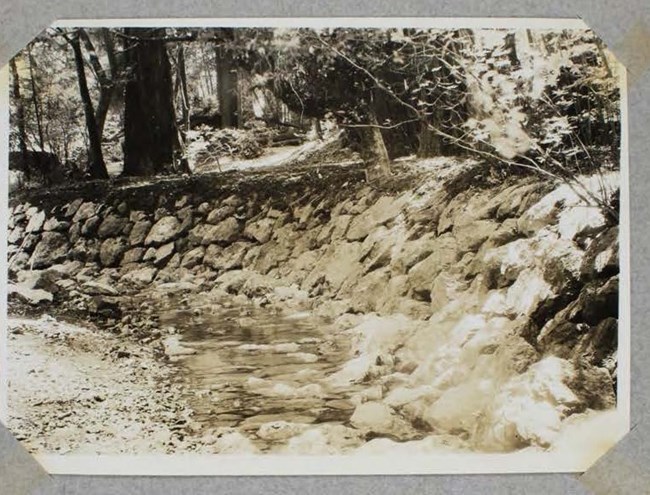Last updated: September 4, 2020
Article
Civilian Conservation Corps Work at Muir Woods

National Archives II, RG 35 Records of the Civilian Conservation Corps
During the 1930s, Civilian Conservation Corp workers shaped and enhanced the natural environment and visitor facilities at Muir Woods.
The Civilian Conservation Corp: Created to Make Jobs
In the 1930s, the Great Depression loomed over America; the unemployment rate rose to 25% and workers across the country struggled to provide for their families. In 1933, the recently elected President Franklin D. Roosevelt created several new agencies designed to get people back to work. The Civilian Conservation Corp (CCC) was one of his most successful and popular agencies. Across the country, this powerful program, originally known as the Emergency Conservation Work program, employed tens of thousands of young unemployed and unskilled men. They lived together in army-managed work camps, that provided food, clothing and a $30 a month salary, most of which was to be sent back to their impoverished families. The CCC crews represented a wide range of men: the Junior Enrollees were young men (ages 18 -26) whose families were on relief rolls; Reservation Native Americans, who worked close to their reservations; local experienced men who were recruited for their forestry experience and over 25,000 older war veterans. By 1942, when American’s entrance into World War II prompted the end of the program, over 2.5 million men had served in the CCC.
From more than 4,500 working camps across the country, the CCC made an indelible mark on the nation’s parks and forests. The crews planted millions of trees, lumbered land, fought forest fires, constructed trails, bridges and campground facilities; cleared and maintained access roads, and managed water features and wildlife refuges. Today, many of our visitor’s favorite national park buildings and trails were a result of the tremendous CCC construction efforts.

NPS Archives
How the CCC Reshaped Muir Woods
Muir Woods, located just north of San Francisco, was designated a national monument in 1908. By the late 1920s and early 1930s, the public’s interest in nature, combined with an increased availability of private automobiles, resulted in increased visitation to Marin County and specifically to Muir Woods National Monument and Mount Tamalpais State Park. San Franciscans arrived in droves to hike the rural hills, picnic in the meadows and ride the Mount Tamalpais Scenic Railway, dubbed the “Crookedest Railroad in the World” because of its 281 curves in just over eight miles of track. Muir Woods Custodian (Superintendent) J. Barton Hershler recognized that the site needed better facilities to accommodate the growing number of visitors and was eager for the CCC’s construction help.
In 1933, over 200 CCC men arrived at Mount Tamalpais State Park and bunked at the Muir Woods working camp. The first men to arrive were from New York State; they were later joined by almost 200 veterans who transferred from Annapolis, Maryland and other various CCC camps and military bases. Once settled, the CCC set to work carrying out improvements at Muir Woods, Mount Tamalpais State Park and on the land belonging to the estate of William Kent. Through 1937, under Custodian Herschler’s direction and later followed by Custodian Finn through 1941, the CCC worked on many different types of projects such as fire protection and flood control, trail improvements, new bridges, visitor amenities such as signs, benches, comfort stations, and picnic facilities, constructing the new entrance gate, a new administration building and improving the Custodian’s Cottage.
NPS Archives

National Archives II, RG 35 Records of the Civilian Conservation Corps

Parks Conservancy / Alison Taggart-Barone
When you visit Muir Woods today, you can still see parts of the CCC's work. Some sections of riprap are still visible along the banks of Redwood Creek. But where salmon need it most, the park is removing the riprap and letting the creek return to its natural flow.

Parks Conservancy / Alison Taggart-Barone
For more information on the history of Muir Woods, please download the Muir Woods Historic Resource Study (NPS, 2006).
